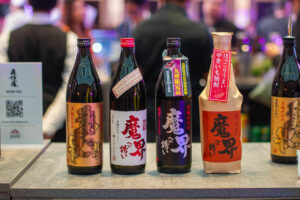SAKÉ is one of the most important drinks of Japan, as it should be, coming from one of their most important food staples, rice (now that’s Japanese efficiency: two products from one crop). While poems, books, and songs have been written about saké in its homeland, it hasn’t quite reached the same level of hype here — but then, we could be wrong.
This year’s Saké Manila, a partnership between Okada Manila and Philippine Wine Merchants (PWM), will be held at Okada’s Grand Ballroom on May 23, beginning at 5 p.m. Tickets are available at https://sakemanila.ph/ for P6,000 each. That brings the guest access to tastings and talks, with 200 premium labels of saké, shochu, whisky, gin, beer, and wine from over 40 distillers and breweries. There’s going to be a cultural showcase with Japanese Taiko drummers and koto players, and a tuna parade and tuna carving.
Last year’s saké spectacle brought in about 100 labels (as opposed to this year’s 200), and more than 1,200 people: “We had to turn down people,” recalled Robi Joseph, director for Philippine Wine Merchants.
The road to 1,200 visitors for the Joseph family (one of the best-known in the Philippines when it comes to importing beverages) started out with Saké Sessions they used to offer at restaurants, pocket sessions designed to educate interested customers about saké. Speaking about this town’s hottest (or chilled; that’s a joke about saké serving temperatures) new drink, he said in an interview a month ago at Okada, “Part of it is the approachability of saké. A lot of people really want to learn more about it; a lot of people who are interested in the culture of Japan.”
“It’s grown; every year,” he said about their growing sales of saké. He recalled a time that they were bringing over two or four container vans filled with just one particular label from Dassai, a saké maker. “It would always get wiped out… they’re just crazy about it.”
Mr. Joseph discussed his own preferences for saké: “It doesn’t trigger my hyperacidity, unlike other wines. I find it easier to drink.
“The buzz is really nice. It’s a different kind of buzz. Like any alcohol, it brings down your walls. But there’s something about saké that just makes you want to talk more,” he said. “Stories, conversations: they’re richer. But that’s just anecdotal.”
He made us taste a Junmai Daiginjo from Tatenokawa — one of the higher grades of saké. The grades are determined by how much the rice has been polished. “The closer you are to that core, the more pure the saké is,” he said, while mentioning that this particular variety had been made with rice polished at 1%, shrinking the grains and making them even more precious. It tasted like plums — despite being made of just rice.
While cheaper saké brands at Japanese restaurants could be had at P300, prices may go up to between P3,000 to P20,000 (the full price range from entry level to premium can be found at Saké Manila).
“It’s really a very special beverage. Just like wine, just like any other alcoholic beverage, it’s steeped in culture and history. Every glass tells a story. There’s so much artistry that goes behind the creation of saké,” he said.
For more information, visit https://sakemanila.ph/. — Joseph L. Garcia

